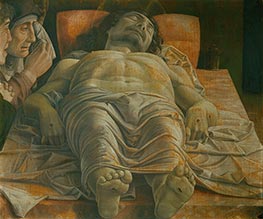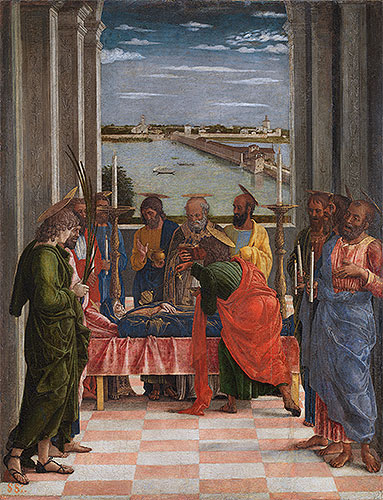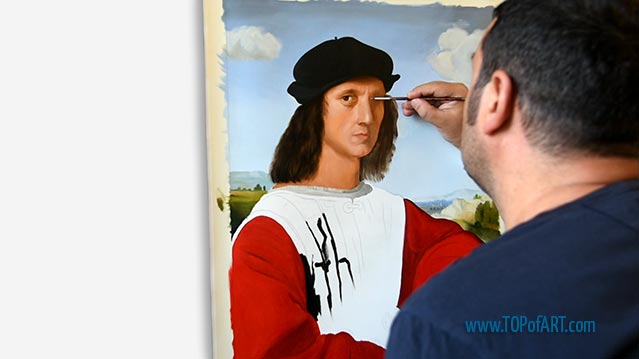Tod der Jungfrau, c.1462 Andrea Mantegna (c.1431-1506)
Standort: Prado Museum Madrid SpainOriginalmaß: 54.5 x 42 cm
Erwerben Sie eine Reproduktion in Museumsqualität: Tod der Jungfrau von Mantegna (c.1462), exklusiv in Öl auf Leinwand gemalt von europäischen Künstlern mit akademischer Ausbildung. Jedes Meisterwerk entsteht in sorgfältiger Handarbeit und fängt die außergewöhnliche Qualität und authentische Pinselführung des Originals ein.
Ölgemälde Reproduktion
Wenn Sie eine andere Größe als die angebotene wünschen
Beschreibung
Gemalt von europäischen Künstlern mit akademischer Ausbildung
Museumsqualität
+ 4 cm Spielraum zum Dehnen
Erstellungszeit: 8-9 Wochen
Erstellungsprozess
Wir schaffen unsere Gemälde in Museumsqualität und unter Berücksichtigung höchster akademischer Standards. Die Gemälde-Reproduktion wird vollständig mit Ölfarben auf eine leere Leinwand gemalt. Wir fügen zusätzlich 4 cm leeren Abstand über die angebotene Gröβe hinzu, welche für strecken der Leinwand auf den Keilrahmen benutzt werden.
Die Schaffung Ihrer Andrea Mantegna nimmt Zeit in Anspruch. Das Bild sollte nicht zu schnell gemalt werden, man sollte keinen Fristen hinterherjagen. Das Bild benötigt Zeit, um hohe Qualität und Detailtreue zu erreichen, sowie um vollständig versandbereit zu trocknen. Abhängig vom Aufwand, von der Detailgetreue und Bildgröße, brauchen wir 8-9 Wochen, um das Bild fertig zu stellen.
Wenn eine Änderung in Bezug auf die Frist notwendig sein sollte, oder sollte Ihre Bestellung in einer für uns äuβerst belebten Periode aufgegeben werden, werden wir Sie per E-Mail über die, von uns für Ihre Reproduktion gebrauchte Zeit, informiert.
Wir rahmen unsere Ölgemälde-Reproduktionen nicht ein. Die Ölgemälde sind ein kostenaufwendiges Produkt, und die Gefahr einer Beschädigung eines im Rahmen gespannten Gemäldes während des Transportes ist äuβerst hoch.
Außerdem gibt es postalische Beschränkungen bezüglich der Größe der Sendung.
Darüber hinaus kann der Versandpreis aufgrund der Abmessungen der gespannten Leinwand den Preis des Produkts selbst übersteigen.
Sie können Ihr Gemälde in Ihrem örtlichen Rahmengeschäft aufspannen und einrahmen.
Versand
Sobald das Gemälde Tod der Jungfrau fertig und trocken ist, wird es an Ihre Lieferadresse versendet.
Wir bieten kostenlosen Versand sowie kostenpflichtige Express-Transportdienste an.
Die Leinwand es eingerollt, in einem festen und sicheren Versandrohr. Sie können den Versandpreis mit dem Tool Geschätzte Steuern und Versandgebühren überprüfen.
Museumsqualität
TOPofART Gemälden stellen wir nur mit Museumsqualität her. Unsere Künstler mit akademischer Ausbildung lassen keine Kompromisse in Bezug auf die Qualität und der Detailtreue des bestellten Gemäldes zu. Wir pflegen keine Zusammenarbeit und werden nie eine solche mit Ateliers mit niedriger Qualität aus dem Fernen Osten zulassen. Wir sind in Europa ansässig, und Qualität ist unsere leitende Priorität.
1 Reviews
5.00 Gesamtbewertung
The upper part of this work was mutilated before it reached the Prado. The missing section represented Christ - enclosed in a sort of wrapping of clouds spangled with cherubim against a background of a vault in the architectural style of Alberti - receiving the soul of the Virgin. A fragment has been found in the Vendeghini Collection in Ferrara. Therefore we can reconstruct the work, aided by the knowledge of a similar iconographic solution in the mosaic of the Mascoli Chapel in St. Mark's, Venice. Various suggestions have been proposed for the relationship between this picture and the mosaic, but critics now believe that the mosaic was a derivation from the Madrid panel, which from its style may be dated about 1460. There is no exact documentation on the work, but it is probable that it was part of the decoration of the chapel in the Castello di St. Giorgio, which Mantegna began for the Gonzaga family in about 1459 and which also included the beautiful panels now in the Uffizi. In the 19th century these were reunited to form a triptych, with the “Adoration of the Magi” in the centre, and the “Circumcision” and the “Ascension” at the sides. By 1460, Mantegna had completed his youthful Paduan experience and was preparing for his masterpiece in the Camera degli Sposi in Mantua. In our small panel the virtuosity of the epic narrator is transformed into an emotional tension that finds expression in the highly composed structure of the circle of Apostles around the bier (only broken by the figure leaning forward and swinging a thurible over the body of the Virgin), and in the chromatic force of every detail. It was the mellowness of colour and perhaps the crystalline luminosity of the landscape elements (a dam on the lake of Mantua?) that suggested Bellini as an author to Adolfo Venturi. This unsustainable hypothesis had a reasonable aspect. It is in the five years between 1456 and 1460 that Bellini was observing Mantegna most attentively, as is proven by his “Transfiguration” in the Museo Correr, which was considered to be by Mantegna.

Beweinung Christi c.1470/1474
€2041
€66.36
Andrea Mantegna
Originalmaß:68 x 81 cm
Pinacoteca di Brera, Milan, Italy

